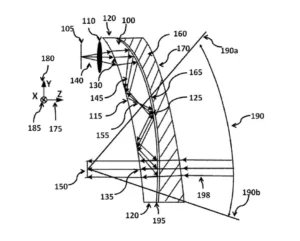Last year, Magic Leap, the Florida-based augmented reality company announced a $542 million financing round with Google leading the way. The announcement came just before Google pulled the plug on the Google Glass Explorer program. We reported then on the investment in Magic Leap, but were unsure what the company was really developing. A recent article by Rachel Metz for the MIT Technical Review shed some light on her visit to Magic Leap’s headquarters.
The company does indeed develop hardware for near to eye display solutions, in other words the company is working on augmented reality glasses. The article explains that the Magic Leap prototype differentiates itself from other solutions by not using an S3D approach. It appears that the differentiating factor is that the company is able to change the focal plane of an augmented reality object to avoid any vergence-accommodation conflict.
The article does not, however, detail any technical details on how Magic Leap accomplishes this. Rachel Metz was, however, impressed with the possibilities of the prototype. A laboratory sized version offered full color and great imagery, while a glasses sized version offered only monochrome (green) images. This is a common approach for early prototypes.
According to its own website, Magic Leap calls its approach Dynamic Digitized Lightfield Signal™ technology. It appears the company is either using a lightfield display or is misusing the term all together. The article also compares the development to the Microsoft HoloLens announcement as a way to interact with holograms.
Assessing what Magic Leap is really working on seems to be better approached by looking at its patent portfolio.
Source: Magic Leap Patent Application
Magic Leap has indeed applied for six patents and also has one granted patent at the US patent office. With a delay between patent application and publication, there may be more patent applications already filed, that are just not visible at this time. The patents address augmented and virtual reality systems and methods as well as display systems and an ergonomic head mounted display. None of these patents addresses light field displays though.
The above image shows an optical element that acts as a waveguide to align the projected image with viewers’ eyes. The element consists of a free form waveguide prism and a free form compensation lens. The augmented reality image is created by means of a small projector based on existing display technologies such as LCOS, DMD, LCD, OLED, etc.
Analyst Comment
Another hint of the company’s plans is the hiring of around 80 engineers, technicians, designers, etc. in the optical, electrical, mechanical, software fields as well as for content development. Deep pockets allow the company to address the development on a much broader basis it seems. – NH

